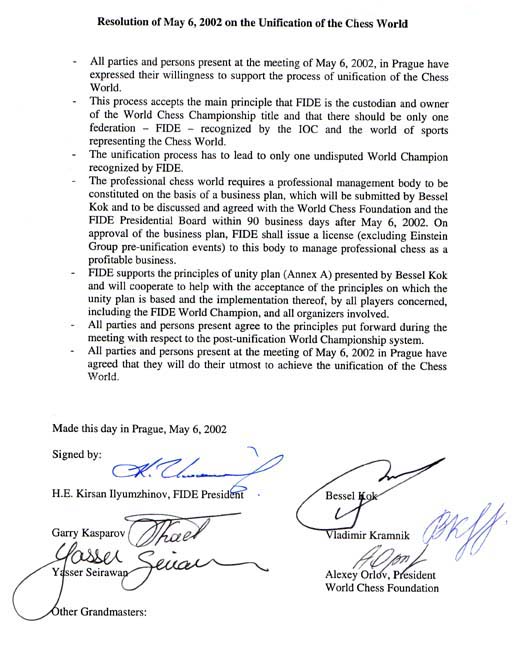
When contacting us by e-mail, correspondents are asked to include their name and full postal address and, when providing information, to quote exact book and magazine sources. The word ‘chess’ needs to appear in the subject-line or in the message itself.
| First column | << previous | Archives [8] | next >> | Current column |
‘I announce my retirement from chess.’ That laconic would-be bombshell somehow failed to jounce the chess world off its axis when published, under the heading ‘Flamboyant Exit’, on page 107 of CHESS, 4 December 1964. The full text of the letter to the editor is given below:
‘I announce my retirement from chess, as from 24 November 1964.
David Mabbs
Harrow, 21 November 1964
P.S. – Please – no more tempting circulars!’
In Linares on 10 March 2005 Kasparov’s declaration of retirement from professional chess was far more of a bomba, and, unlike Mr Mabbs, he will certainly receive many a tempting offer to recant his decision. For now, though, he goes down in history among those world champions whose careers ended on a sombre note, i.e. all of them.
After enjoying a decade and a half of pugnacious pre-eminence, Kasparov lost a matchlet to Kramnik in Hammersmith, London in 2000 through atypically listless play, after which his supporters, and then others, took to describing him not as ‘the former world champion’ but, on account of his rating, as ‘the world’s number one player’. It was an Elo-inspired variation of the description of Capablanca on the title page of the US edition of his 1935 book A Primer of Chess: ‘World’s foremost chess expert’.
In the late 1990s FIDE was favouring rapid play, knock-out tournaments, mini-champions and, more generally, whatever flew in the face of chess tradition. In the meantime, the top masters were left to their own devices. At first they indulged in tractations about a new world championship cycle, with each potential contender seeing any anticipated personal benefit as a birthright and any putative personal disadvantage as an affront. But was it all really necessary? If a direct re-match had been organized between Kramnik and Kasparov, without any qualification system, the other leading lights would, of course, have complained long and hard, yet Kasparov’s status was incomparable and anno Domini was becoming a factor.
Qualifying matches were projected, announced and abandoned, but in May 2002, 18 months after the Hammersmith débâcle, the seemingly impossible was achieved in Prague with the thrashing-out and signing of a Resolution ‘on the Unification of the Chess World’. Although a compromise which fell short of Yasser Seirawan’s original proposal, it became the only realistic prospect of bringing about a match for the undisputed world championship.

Throughout that process, steered by Seirawan, Kasparov conducted himself better than most and better than usual. All the signatories undertook to ‘do their utmost to achieve the unification of the Chess World’, but ‘utmost’ is an undefinable word. More qualifying matches were projected, announced and abandoned, and when the Resolution eventually wilted away into limbo Kasparov was the most aggrieved party. Some of his detractors no doubt viewed this as his come-uppance, and it could indeed be regarded as the culmination of events which he himself had set in train during the nadir of his chess career, i.e. the break-away from FIDE in 1993. That episode, which has caused world championship bedlam for a dozen years, was seen as an obvious calamity by any level-headed observer at the time. To Kasparov, however, the reality did not sink in until much later: on page 13 of the 2/1999 New in Chess he described the founding of the PCA in 1993 as his biggest mistake of all.
A pattern can be discerned which takes us to the heart of how Kasparov’s off-the-board career went off the rails and how his personal reputation slumped from unparalleled heights. Until the mid-1980s he was widely regarded as the unimpeachable golden boy of chess, the fresh newcomer/victim/anti-Communist who stood in such stark, attractive contrast to Karpov. Increasing shifts of opinion against Kasparov were detectable from 1985 onwards, but it was not until 1987, and the publication of his autobiography Child of Change, a deeply untrustworthy shambles, that the real deterioration in his public standing began. Kasparov failed to realize that if a book of his repeatedly made statements which did not add up, including vicious scatter-gun attacks, readers would notice and some of them would even say so publicly. For him, however, this was another epiphany which came far too late. (On page 49 of the 1/1990 New in Chess he acknowledged what all but the oiliest sycophant had recognized since the year of the book’s publication: ‘I deserved the critical reception of Child of Change.’)
In the above-mentioned 1999 issue of New in Chess Kasparov added that he had made ‘so many mistakes’ and that ‘many things went wrong, both in business and in chess’. Such breast-beating, a rarity for a chessmaster with a jumbo ego, prompts a simple question: why has he been so prone to making so many mistakes that were so easily identifiable and avoidable? The explanation, we believe, is a fil rouge through his chess career: singularly poor personal judgment (aggravated by hot-headedness) which not only causes gaffes of all kinds but also makes him incapable of selecting an appropriate entourage to help protect him against recurrences. Nobody was there to persuade him in 1993 that his urge to abandon FIDE would occasion almost universal condemnation. Nobody convinced him in 1986-87 that publication of Child of Change was an insult to the intelligence of any reader and would, sooner or later, do untold harm to his own reputation. Nobody ensured that he steered clear of cheap literary associations with can’t-learn-won’t-learn writers. Nobody has made him see, even today, that his moribund ‘chesschamps’ website, about which he was formerly so enthusiastic, would be unworthy of a junior fan, let alone a figure of his standing. The Predecessors series is a further example of how Kasparov’s passion for truth and the highest standards at the chess board has difficulty in spreading elsewhere. Before volume two had even been published he was showing (limited) contrition over what had gone so badly wrong with volume one and how amends might be made in a revised edition. But why did he receive no proper counsel on that high-profile project before anything at all was published?
Whereas Fischer, even during his periods of relative mental steadiness, viewed attempts to befriend or assist him with narrow-eyed paranoia, Kasparov’s failure has been at the opposite extreme and has, down the years, enabled some spectacularly unsuitable individuals to work their way in as neo-associates and pseudo-friends. A master with Kasparov’s star quality and marketability inevitably has to endure many opportunistic approaches from those wanting a seat in the inner circle, and, in his own interests, he should have obstructed each new arrival on the threshold with an inquisition which began: ‘Halt. Who goes there? Friend or leech?’
Who, if anyone, gave Kasparov helpful advice over his wish to abandon professional chess is impossible to know. There will be a widespread yearning for him to resume, one day, a chess career of some kind, for it seems improper and unwarranted that lovers of the game, and not least in future generations, should be denied any brilliancies by him bearing a date later than 2005. It must be hoped that, at a moment of his own choosing and properly advised, this chess genius but deeply flawed man will revoke a retirement announcement which – in terms of his age, at least – is the equivalent of Emanuel Lasker folding up his board in 1910.
Pages 104-105 and 261-262 of Chess Explorations cited
some lesser-known instances of chessplayers announcing their
retirement from the game or, at least, contemplating withdrawal:
Botvinnik (in 1941); Capablanca (1924); Euwe (1933); Lasker
(1931); Marshall (1909); Pillsbury (1901); Steinitz (1891).
[Correction: in the case of Botvinnik, for 1941 read 1946.]
We observe in passing that nobody has yet cobbled together an ‘instant’ post-retirement book on Kasparov. However, it may not be a long wait, given that his marketability has often, over the years, prompted the hastiest cobblers.
In Psychoanalytic Observations on Chess and Chess Masters (New York, 1956) Reuben Fine stated (page 51) that Lasker ‘invented a kind of tank in World War I’. (In the 1967 Dover reprint, The Psychology of the Chess Player, the quote is on page 45.) What more is known about this?
On page 192 of Kings, Commoners and Knaves, in an article on Juan Corzo, we mentioned Celso (‘Celsito’) Golmayo, who was the son of Celso Golmayo y Zúpide and the brother of Manuel. Celsito, it was noted, won the 1897 Cuban championship in Havana after a play-off against Andrés Clemente Vázquez. We should like to find out more about him, for it was uncommon in the nineteenth century for a teenager to become a national champion. On page 183 of Ajedrez en Cuba (Havana, 1960) Carlos A. Palacio gave bare details of the tournament, stating that Enrique Ostolaza came third, Juan Corzo fourth and Manuel Golmayo fifth.
A brief obituary of Cels(it)o Golmayo was published on page 97 of the April 1924 La Stratégie. Although it stated that he had died in Seville at the age of 42, Jeremy Gaige’s Chess Personalia (which mentioned the French magazine) gave his year of birth as 1879, and this does not match up. However, another source also had 1879: ‘Celso Golmayo y de la Torriente (Habana 1879)’ was the reference on page 202 of Primer libro del ajedrecista by J. Paluzíe y Lucena (8th edition, Barcelona, 1938).
La Stratégie, June 1921, pages 147-148 published the following game:
Cels(it)o Golmayo – A. Gómez
Madrid, 13 June 1921
Scotch Gambit
1 e4 e5 2 Nf3 Nc6 3 d4 exd4 4 Bc4 Bc5 5 c3 Nf6 6 cxd4 Bb4+ 7 Bd2 Bxd2+ 8 Nbxd2 d6 9 O-O O-O 10 d5 Ne7 11 Qc2 Ng6 12 Rac1 Ne8 13 Bb5 Bd7 14 Bxd7 Qxd7 15 Nd4 Qg4 16 h3 Qf4 17 g3 Qh6 18 Kg2 Ne7 19 f4 Rc8 20 Qa4 a6 21 Qd7
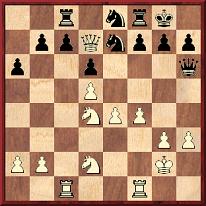
21...Nf6 22 Qxe7 Rfe8 23 Nf5 Qh5 24 g4 Nxg4 25 Qg5 Ne3+ 26 Nxe3 Qe2+ 27 Rf2 Qxe3 28 Rc3 Qd4 29 Rg3 Resigns.
Another score, from a few years previously, appeared in an article by José Juncosa on pages 152-154 of Ajedrez Español, May 1943:
Cels(it)o Golmayo – Yovanoff
Barcelona, 1918
Max Lange Attack
1 e4 e5 2 Nf3 Nc6 3 d4 exd4 4 Bc4 Nf6 5 O-O Bc5 6 e5 d5 7 exf6 dxc4 8 Re1+ Be6 9 Ng5 Qd5 10 Nc3 Qf5 11 g4 Qxf6 12 Nd5 Qd8 13 Rxe6+ fxe6 14 Nxe6 Qd6 15 Bf4 Ne5 16 Ndxc7+ Kd7
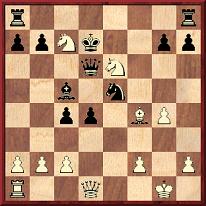
17 Qe2 Rae8 18 Nxe8 Rxe8 19 Nxg7 d3 20 Nxe8 dxe2 21 Nxd6 Nf3+ 22 Kg2 e1(Q) 23 Rxe1 Nxe1+ 24 Kf1 Nf3 25 Nxc4 Resigns.
Juncosa’s article, the only one we have found on C. Golmayo, gave his date of death as 22 January 1924 and stated that in Havana in 1897 Lasker predicted that the boy, then barely 15, was a probable successor to his world championship title:
‘Cuando apenas si contaba quince años, fué saludado en La Habana “como probable sucesor suyo”, por el entonces campeón del mundo Dr. Em. Lásker; en la misma fecha en que rotundamente ganaba al maestro doctor Vázquez un “match” en que se decidió el desempate del primer puesto en el Torneo-campeonato del Club Ajedrez de dicha ciudad – año 1897 – .’
If La Stratégie is correct, Celsito could indeed have been 15 years old in 1897, but there is still a problem: Lasker’s visit to Havana was in 1893, before he became world champion.
Frank Camaratta (Toney, AL, USA) writes:
‘The Philidor chess men were registered in 1850 in the UK and manufactured by George Merrifield. The advertisement for them ran for around six months in a London publication. Staunton ridiculed the design, and that did not help the popularity of the chessmen. They never took hold and had a production run of about a year. I own one full set and one incomplete set. As far as I can determine, they were offered in boxwood/ebony as well as ivory and in two sizes, a 10 cm king and an 11 cm king.’
Our correspondent has provided the following illustration from his collection:
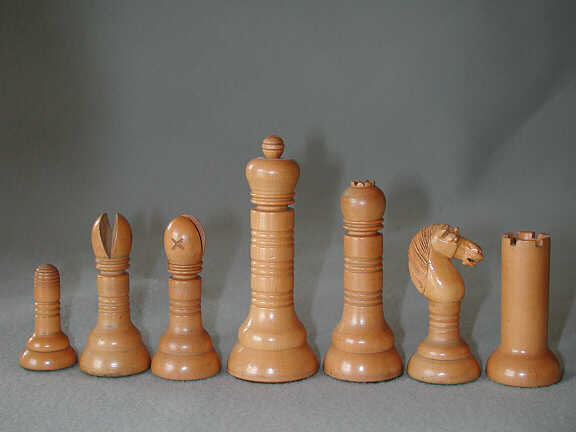
Frank Camaratta also reverts to a matter outlined in C.N. 360 (see page 109 of Chess Explorations): the court action taken by John Jaques & Son, Ltd. against CHESS after the magazine’s 14 September 1937 issue featured an advertisement for ‘genuine Staunton chessmen’, whereas they had not been manufactured by Jaques. CHESS lost the suit, but won on appeal. In addition to the article by Fred Wren mentioned in C.N. 360, an account of the affair by Gareth Williams on pages 28-31 of CHESS, September 2001 may be noted.
Mr Camaratta asks for a copy of the offending advertisement, as his 1937 issues of CHESS are in bound form and lack the covers (where the magazine’s advertising material appeared). Our own copies for the 1930s are also bound and coverless, but a reader will certainly be able to show us exactly what appeared in issue 25 of CHESS to provoke what the magazine later called (on page 351 of the July 1939 number) ‘the chess lawsuit of a century’.
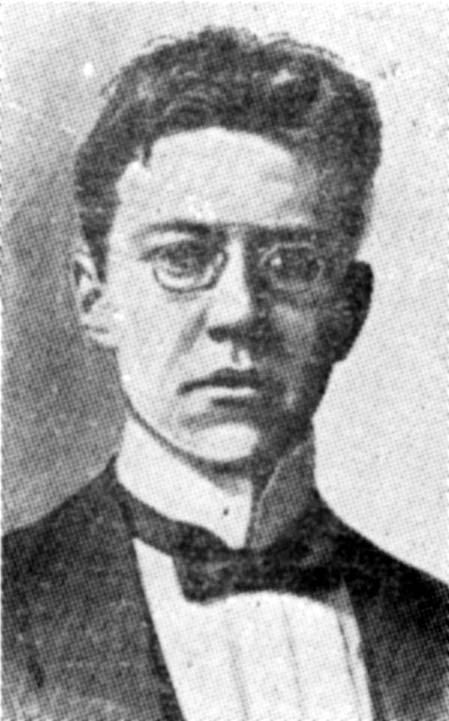
C.N. 2776 asked unavailingly if any readers could trace German
press reports about the suicide of Rudolf Swiderski, at the age
of 31, in Leipzig on 12 August 1909. Now, though, Jerry Spinrad
(Nashville, TN, USA) sends us the following from the Washington
Post, 12 August 1909:
‘Famous Chess Player a Suicide.
Special to The Washington Post.
Berlin, Aug. 11. – Swiderski, the celebrated chess player, was found dead today. Apparently he had poisoned and shot himself.’
Of course, such a lamentable affair cannot be left with an ‘apparently’, but there is in any case a major discrepancy which will, we hope, now prompt a reader in Germany to investigate what appeared in the local press: if Swiderski died on 12 August (as chess reference books affirm), how could the despatch from Berlin be dated 11 August?
The death-date 12 August was given on page 286 of the September 1909 Deutsche Schachzeitung, which reported that Swiderski had killed himself on account of his living circumstances and rather than undergo a necessary operation: ‘Am 12. August schied Swiderski aus eigener Entschliessung aus dem Leben. Unzufrieden mit seinen Lebesverhältnissen und von Krankheit heimgesucht, zog er den Tod einer notwendig gewordenen Operation vor.’
Deutsches Wochenschach (15 August 1909, pages 285-286) gave no exact date, merely stating that he had died suddenly in the past week. Deutsche Schachblätter (15 August 1909, page 56) accorded Swiderski’s death five lines, reporting that he had died suddenly in his 31st year. Nor was a date specified by L. Bachmann is his obituary of Swiderski on page 194 of Schachjahrbuch für 1909 (Ansbach, 1909). The Wiener Schachzeitung (October 1909, pages 351-352) printed an impossible date of death (2 September), whereas the American Chess Bulletin (October 1909, page 227) put 2 August.
Of the reports currently known to us, only the Washington Post indicated, speculatively, the cause of death (i.e. the unusual combination of poisoning and shooting). Moreover, it stated that on 11 August Swiderski was ‘found dead’, which does not necessarily mean that he died that day.
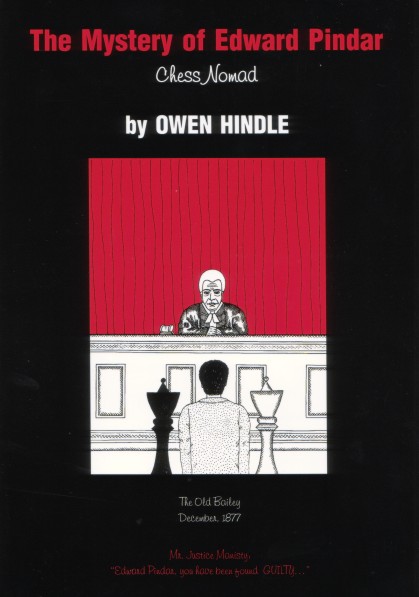
Owen Hindle (Cromer, England) has sent us a copy of his latest work, The Mystery of Edward Pindar (Ostrava, 2005), a book with a bombshell. Normally we do not just quote the back-cover blurb, but in this case our wish is to avoid spoiling the surprise:
‘This book presents facts, hitherto unknown to the chess world, that solve many of the mysteries of Edward Pindar’s life. Included are new insights into the Morphy game and the matches with Blackburne, but the key discovery is the event in 1877 that dramatically ended his twin careers of language teacher and professional chess player.’
We add merely that the event entailed considerable violence and that Pindar found himself in the Central Criminal Court at the Old Bailey, London.
Andy Ansel (Walnut Creek, CA, USA) has sent the back-cover advertisements which appeared in CHESS, 14 September 1937 and 14 October 1937:
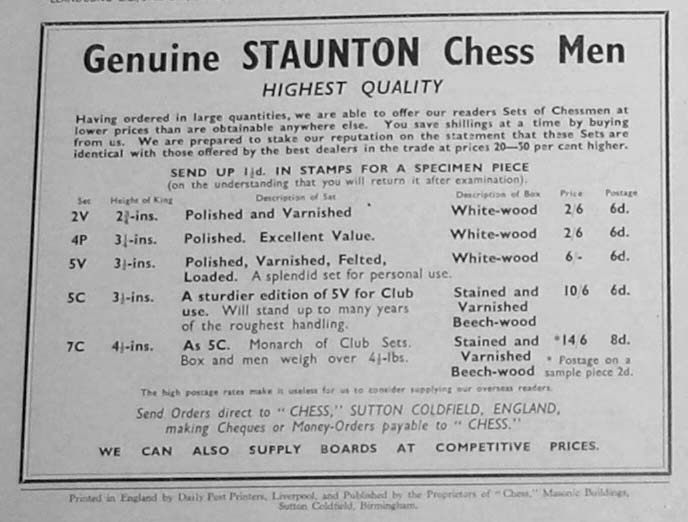

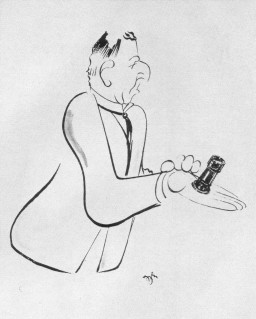
The solutions will be provided shortly to the various Dudeney problems (C.N.s 3633 & 3644), and we shall also be reverting to the Harkness/Kotov topic (C.N. 3639), thanks to contributions/translations received. Contributors are reminded that their full name and address are required. Generous remarks about this column are, naturally, much appreciated but are always – again, naturally – edited out.
C.N. 3639 quoted the following passage from page 242 of Official Chess Handbook by K. Harkness (New York, 1967):
‘So far as the complaints of collusion among Soviet players are concerned, it is undoubtedly true that the Soviet contestants in FIDE tournaments, especially in the early competitions, have played as a team and not as individuals. Alexander Kotov admits this in his Memoirs of a Chessplayer, published in the USSR in 1960. He apologizes for his victories over Smyslov in 1933 [sic – 1953] and Botvinnik at Groningen in 1946, and hopes he will be forgiven, since he made up for these lapses by defeating Reshevsky and Euwe respectively in these tournaments.’
From Steve Giddins (Moscow):
‘Harkness’s reference to Kotov’s “Memoirs of a Chessplayer” presumably means the book Zapiski Shakhmatista (Moscow, 1957), a title more appropriately rendered as “Notes (or Jottings) of a Chessplayer”. I have translated into English the relevant passages concerning the Groningen, 1946 game against Botvinnik (pages 121-122) and Kotov’s win over Smyslov at Zurich, 1953 (pages 196-197). The 1960 edition of Kotov’s book was effectively just a reprint, with no material textual changes.’

Our correspondent’s translations are given below. Firstly, from pages 121-122 and Groningen, 1946:
‘When Botvinnik had established a clear lead and Euwe was trailing him, various reactionary newspapers decided to support their champion by means of the familiar propaganda: “It’s impossible to compete with the Russians”, claimed one Catholic newspaper. “One only has to look at how they have all lost intentionally to Botvinnik. Smyslov lost to him, Boleslavsky also. We know for a fact that they are all under strict orders to lose to Botvinnik without any struggle, and thereby assist him into first place!”
This unceremonious invective contained as much truth as it did logic. In the first place, Botvinnik had won both the games against his Soviet rivals only after sharp battles, subtly outplaying his opponents. Secondly, Botvinnik’s lead did not result from just two games – two points is hardly enough to put one in the lead after 13 rounds of a tournament. Botvinnik had also beaten eight other players from various countries in Europe and America. But, as is well known, invective has no need of logic!
Throughout the first 13 rounds of the tournament, this Catholic paper kept up similar commentary. However, it did not help Euwe. Although he remained hot on Botvinnik’s heels, he could not catch him.
Then came the 14th round, in which I played Botvinnik. The tournament leader played the opening badly and too riskily and, having reached an inferior position, overlooked a relatively straightforward combination and lost. The Dutch were celebrating. Botvinnik is beaten! To their surprise, a compatriot had done to Botvinnik what the Western masters had been unable to do. Now Euwe had caught up with Botvinnik. We ourselves were highly interested in one question: what would the newspaper which had been screeching about a conspiracy between the Russians say now? How would they get out of the ticklish position in which they now found themselves?
It would appear that the shameless know no bounds. On the following day, the newspaper reported my game with Botvinnik in detail, and placed it under the headline: “Russian defies Kremlin orders! Future fate of Kotov uncertain!”.
What more can one say about such filthy slander and evil-minded fantasy?’

Alexander Kotov
From pages 196-197:
‘Smyslov’s only defeat in the Zurich tournament was against the author of these lines. At that point, Smyslov was leading. I was somewhere in the middle of the tournament table. Reshevsky was right behind Smyslov. The reader will understand my situation: just as in Groningen, I had obstructed a colleague’s path to the supreme sporting title, without the win bringing any material improvement to my own tournament position. I understood very well the absurdity of what had happened, and that I would not get any plaudits for this win over Smyslov from my compatriots, who so closely shared in the successes of the Muscovite. It is sufficient to say that when, as usual, I telephoned my wife in Moscow that evening, she immediately asked me:
“What are you playing at over there? I’ve had chess fans on the phone here, cursing you. Is that what you want?”
But there was nothing to be done – sport is sport! I secretly hoped that I would be able to undo some of the damage later on. I still had one more game to play against Smyslov’s main rival, Reshevsky. And so it happened. Exploiting Reshevsky’s inaccuracies, I won. Thus, the Groningen story was repeated.’
Mr Giddins comments:
‘It is quite clear from the above that no admission of the sort that Harkness alleges is made; quite the contrary. Indeed, it is inconceivable that any such admission could have been made, given Kotov’s known Communist loyalties, and the heavy hand of the Soviet censor. I can only assume that Harkness himself did not understand Russian (a supposition supported by his mistranslation of the book’s title) and was merely reciting something he had been told by somebody else. It may be that, in some other context, Kotov joked about asking “forgiveness” for beating his colleagues, but to suggest that this amounts to an admission of a conspiracy is quite unjustified.
One point worth clarifying is that in the Smyslov section Kotov refers to having, for the second time, “obstructed a colleague’s path to the supreme chess title”. It may be wondered in what sense his defeat of Botvinnik at Groningen, 1946 could be said to have done this. The answer is that, when discussing Groningen, Kotov makes great play of the fact that, had Botvinnik not taken first place ahead of Euwe, the latter would almost certainly have been declared world champion by FIDE, without any match-tournament taking place. Kotov therefore argues that winning Groningen was an essential step for Botvinnik in securing the chance to play for the world title.’
We are grateful too to Claes Løfgren (Randers, Denmark), who has also provided translations from Kotov’s book, commenting to us, ‘I do not see any admission of foul play’. That conclusion is shared by Christian Sánchez (Rosario, Argentina), who has submitted extracts from the Spanish translation of Kotov’s book, Apuntes de un ajedrecista (Moscow, 1959).
C.N. 3617 noted that three people, V. Halberstadt, J. Le Monnier and B. Reilly, are on record as having seen the Alekhine ‘Nazi articles’ in his handwriting. Steve Giddins now quotes the following from an article by Boris Spassky on page 14 of Shakhmatnaya Nedelya, March 2005:
‘... a good friend of mine, a retired Canadian professor of mathematics, personally saw Alekhine’s handwritten pages in the archive of Brian Reilly.’
This appears to be another of Spassky’s historical muddlings
(see also, for instance, C.N. 3425). In any case, we are aware
of no ‘retired Canadian professor of mathematics’ who is capable
of making authoritative or reliable statements about Alekhine.
On pages 78-80 of Kings, Commoners and Knaves, pages 86-87 of A Chess Omnibus and in C.N. 2920 games were presented in which a knight gave mate with its first move. Below is a further specimen, and our first featuring a discovered mate:
J.A. Edwards – N.N.
Postal Chess Club Handicap Tournament, 1963
King’s Gambit Accepted
1 e4 e5 2 f4 exf4 3 Nf3 Be7 4 Bc4 Bh4+ 5 g3 fxg3 6 Bxf7+ Kxf7 7 Ne5+ Ke6 8 Qg4+ Kxe5 9 O-O gxh2+ 10 Kh1 Bf6 11 d4+ Kxd4 12 Be3+ Kxe3 13 e5 Bxe5 14 Re1+ Kf2 15 Qg2+ Kxe1
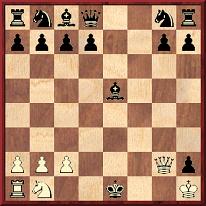
16 Nc3 mate.
Source: CHESS, Whitsun, 1963, page 264.
Bernard Levin was a British writer of the supposedly highbrow variety who, like Arthur Koestler and George Steiner before him (see C.N.s 3256 and 3266), occasionally wrote about chess, on autopilot, if a world championship match was in the news. We recently came across a piece by Levin on pages 171-174 of his anthology All Things Considered (London, 1988). Endowed with the catchpenny title ‘The mating game’, it had already somehow received space in the (London) Times, of 9 November 1987, and was the usual dollop of flash-fried offal served by writers who think that a readable overview of chess can be rustled up for the populace by cribbing tittle-tattle from books like Cockburn’s Idle Passion, Fine’s The Psychology of the Chess Player and Schonberg’s Grandmasters of Chess.
A prime objective of such output is to deride chess masters (particularly dead ones), and we quote just one passage from Levin’s ‘The mating game’, i.e. the sum total, ‘all things considered’, of what he had to impart about Emanuel Lasker:
‘Lasker, for instance, tried a variety of business schemes, all of which came to nothing (or to bankruptcy), his record being a pigeon-breeding establishment which failed, not surprisingly, because he tried to mate two male pigeons to get the thing properly started.’
The pigeon yarn is often seen, and in C.N. 1048, an examination of The Kings of Chess by W. Hartston (London, 1985), we commented:
‘The Lasker chapter captures the German champion vividly but still cannot resist churning out vague claims (page 81) about his “being swindled by all who did business with him”, trying to mate two male pigeons, despising imitation flowers, etc. (We might point out that Dus-Chotimirsky – Lasker & His Contemporaries, issue 4, page 140 – quotes Lasker as saying that he could not stand real flowers, but we have no wish to launch a debate on his floral tastes ...)’
When the unsubstantiated pigeon story about Lasker started circulating is difficult to say, but it was a staple feature of chapter 22 of Emanuel Lasker Biographie eines Schachweltmeisters by J. Hannak (Berlin-Frohnau, 1952) and chapter 21 of the English version, Emanuel Lasker The Life of a Chess Master (London, 1959). Since many parts of Hannak’s book read like a novelette, it may reasonably be felt that something more substantial is required before Lasker is mocked.
If any outsider is to cast an eye over chess and chessplayers, how we wish that it could be a truly outstanding writer with the finest insight, such as Alan Bennett.
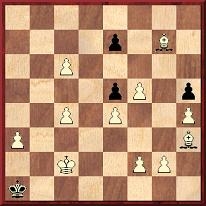
White mates moving only his bishops.
The above problem by H.E. Dudeney was published on page 406 of the December 1917 BCM, and the solution appeared on page 31 of the January 1918 issue. This states that after 1 Bxe5+ no mate is possible, and the main line is given as follows:
1 Bh6 Ka2 2 Bc1 Ka1 3 Bd2 Ka2 4 Bb4 Ka1 5 Bc3+ Ka2 6 Bb2 e6 7 Bc1 Ka1 8 Bd2 Ka2 9 Bb4 Ka1 10 Bc3+ Ka2 11 Bb2 exf5 12 Bxe5 Kxa3 13 Bd6+ Ka4 14 Bxf5 Ka5 15 Bc5 Ka6 16 Bc8+ Ka5 17 Bb7 Ka4 18 Bb6 Kb4 19 Ba6 Ka4 20 Bb5+ Kb4 21 Ba7 Ka5 22 Bd4 Kb4 23 Bb6 Ka3 24 Ba5 Ka2 25 Bb4 Ka1 26 Ba4 Ka2 27 Bb3+ Ka1 28 Bc3 mate.
The caricature, by Zen, was of Harry Golombek, as given in III° torneo internazionale di scacchi Venezia 1949 by H. Müller (Venice, 1950).
From Christian Sánchez (Rosario, Argentina):
‘Page 321 of El Ajedrez Argentino, 1947 has annotations to the game Maderna-Pizzi played in that year’s Mar del Plata tournament. After 12...Be6 K. Skalička says: “La variante Cotlar, analizada ampliamente en la revista chilena Jaque Mate Nº 12.” (That same magazine is to be found in the bound volume that forms the book Torneo Internacional de Ajedrez Mar del Plata 1947 by K. Skalička.)’
In the late 1990s we started compiling an ‘address book’ featuring leading chess personalities of the olden days. The list is now made available here and will be expanded from time to time.
Gerhard Henschel’s 1959 book Freude am Schach was discussed in C.N. 3533 in the context of two highly dubious games claimed by him to have been played by Einstein and Stalin. On pages 93-94 of the same book Henschel gave a game purportedly won by Leo Tolstoy (1828-1910) from a royal opponent (‘gegen den Fürsten Ivkoff’): 1 e4 e5 2 d4 exd4 3 c3 dxc3 4 Bc4 cxb2 5 Bxb2 d6 6 Qb3 Qe7 7 Nc3 Nd7 8 Nf3 Nc5 9 Qc2 Be6 10 Nd5 Bxd5 11 Bxd5 Nf6 12 O-O c6 13 Bc4 Rd8 14 Rfe1 Ne6 15 e5 dxe5 16 Nxe5 g6 17 Nxf7 Qxf7 18 Rxe6+ Kd7 19 Rd1+ Kc7 20 Be5+ Bd6 21 Rexd6 Qe7 22 Rd7+ Kb6 23 Bc7+ Kc5 24 Be2+ Kb4 25 Qb3+ Kc5 26 Qc4 mate.
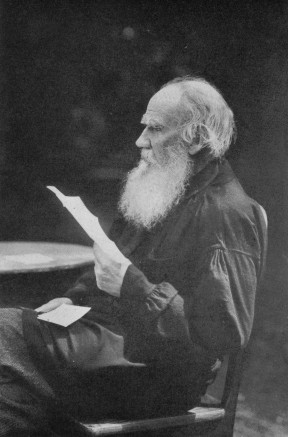
Count Leo Tolstoy
Anyone making a check of Tolstoy games runs into instant chaos. For instance, page 413 of Şah Cartea de Aur by Constantin Ştefaniu (Bucharest, 1982) had a game which began 1 e4 e5 2 f4 exf4 3 Nf3 g5 4 Bc4 g4 5 Ne5 Qh4+ and was won by White at move 21. It was headed ‘Lev Tolstoi – E. Mood, Iasnaia Poliana, 1908’. Moreover, databases have the following: S. Lebedev v L. Tolstoy, correspondence, Russia, 1900 (a game which started 1 d4 d5 2 c4 dxc4 3 Nf3 Nf6 4 e3 Bg4 5 Bxc4 e6 and was won by Black at move 39) and L. Tolstoy v A. Romashkevich, correspondence, Russia, 1901 (which opened 1 e4 e5 2 Nf3 Nc6 3 c3 d5 4 Qa4 f6 5 Bb5 Nge7 and was won by White at move 60). In each case the full score is on offer, but we dislike reproducing games from databases unless a reliable old source can be found. As will be shown later on, moreover, Leo Tolstoy was not the only chess-playing member of his family, and we are currently by no means sure that he played those, or any other, correspondence games.
Nor are snippets about Leo Tolstoy in chess magazines necessarily informative or reliable. The following paragraph appeared on page 168 of the May 1897 BCM:
‘Count Tolstoi, who is now staying at St Petersburg, is said to be devoting himself enthusiastically to the study of chess. It is reported that he and his wife and children are playing as if their lives depended on the results. The tables in the various rooms are marked out as chess boards, and the dogs and other pets are named after the chess pieces. This sort of thing of course cannot last.’
The first instance we have so far traced of a game by Tolstoy appearing in print is an article in the Rigaer Tageblatt, subsequently reproduced on pages 157-158 of the May 1907 Deutsche Schachzeitung and in a feature ‘Tolstoi als Schachspieler’ on pages 20-21 of Schachjahrbuch für 1907. II. Teil by L. Bachmann (Ansbach, 1908). This is Tolstoy’s best-known game, against Aylmer Maude (1858-1938), who was his biographer and translator. It was stated to have been played the previous October, and the moves were given as follows: 1 e4 e5 2 f4 exf4 3 Nf3 g5 4 Bc4 g4 5 Ne5 Qh4+ 6 Kf1 d5 7 Bxd5 f3 8 gxf3 Qh3+ 9 Ke1 g3 10 d4 g2 11 Rg1 Qh4+ 12 Ke2 Nh6 13 Rxg2 c6 14 Bxh6 cxd5 15 Bxf8 Kxf8 16 Qe1 Qe7 17 Nc3 f6 18 Nxd5 Qd6 19 Qg3 Resigns. This, of course, is the game published by C. Ştefaniu with the wrong date and the wrong spelling of Black’s name.
Maude wrote a two-volume biography of Tolstoy, and this game (continued with 19...fxe5 20 Qg7+ Ke8 21 Qxh8+ ‘and wins’) was one of two that he presented on pages 673-675 of the second volume, The Life of Tolstoy Later Years (London, 1910). His introductory paragraphs read:
‘Games played, as these were, rapidly, amid conversation, and when one of the players had been travelling all the preceding night, cannot have much interest as specimens of good chess. But as showing the kind of skittle game a great writer who only plays when he is too tired to work, played at the age of 78 and 81, they may be worth recording.In the first game, played in 1906, Tolstoy, who knows nothing of the chess books, took me quite by surprise by playing the Salvio Gambit. He had, it turned out, picked it up from a friend who had recently played it on him. I knew nothing about that opening, and made a very poor fight of it.’
Maude stated that the second game, in which he was White, was played in 1909 and went as follows: 1 e4 e5 2 Nf3 Nc6 3 Bb5 a6 4 Ba4 b5 5 Bb3 Nf6 6 Ng5 d5 7 exd5 Nxd5 8 Nxf7 Kxf7 9 Qf3+ Ke6 10 Nc3 Nb4 11 a3 Bb7 12 axb4 Ra7 13 Qg4+ Kd6 14 Ne4+ Kc6 15 Qe6+ Bd6 16 Bxd5+ Kb6 17 Bxb7 Rxb7 18 d3 Ka7 19 Be3+ Kb8 20 Rxa6 Re8 21 Qa2 c6 22 Ra8+ Kc7 23 Qa5+ Kd7 24 Rxd8+ ‘and wins’.
Maude’s two-volume work had a number of other references to chess, and we begin with those in volume one, The Life of Tolstoy First Fifty Years (London, 1908):
Page 77:
‘He had a third chance of securing it [a St George’s Cross for bravery] later on, but this time, absorbed in playing chess till late at night, he omitted to go on duty, and the Commander of the Division noticing his absence, placed him under arrest and cancelled the award which had been already made in his favour. Chess, I may here mention, has always been a favourite game of Tolstoy’s. He has never studied the game from books, but has played much and plays well.’
Page 119:
‘One evening [in Sevastopol], while Tolstoy was sitting with the adjutants of Count Osten-Saken, Commander of the Garrison, Prince S.S. Ourousof [Urusov], a brave officer and first-rate chessplayer (he took part in the International Chess Tournament of 1862, in London [sic - he did not]) and a friend of Tolstoy’s, entered the room and wished to speak to the General. An adjutant took him to Osten-Saken’s room, and ten minutes later Ourousof passed out again, looking very glum. After he had gone, the adjutant explained that Ourousof had come to suggest that a challenge should be sent to the English to play a game of chess for the foremost trench in front of the Fifth Bastion: a trench that had changed hands several times and had already cost some hundreds of lives. Osten-Saken had naturally refused to issue the challenge.’
Pages 166-167 of King, Queen and Knight by N. Knight and W. Guy (London, 1975) quoted from a letter dated January 1899 from Tolstoy to a friend in which he related this incident.
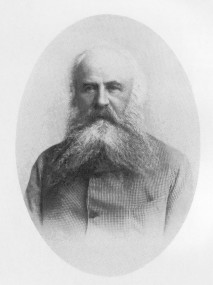
Prince S.S. Urusov
Page 389 of the first volume of Aylmer’s work quoted an unidentified lady regarding an episode in 1878:
‘Knowing that he was fond of chess, the Countess Tolstoy asked [Ivan Tourgenef/Turgenev] to play a game with her eldest son, a lad of 15, saying, “He will all his life remember having played with Tourgenef.”
Tourgenef condescendingly agreed, and began a game, while continuing to talk to us.
“In Paris I often used to play chess and was considered a good player. They called me le chevalier de pion. I am fond of pawns. ... Do you know the new phrase, now in fashion among the French – vieux jeu? Whatever you say, a Frenchman replies, ‘Vieux jeu!’.”
“Eh! but one must not joke with you”, he exclaimed suddenly, turning to his youthful opponent. “You have all but done for me.”
And he began to play carefully, and only won the game with difficulty, for young Tolstoy really played chess excellently.’
The above passage resulted in a remarkable misunderstanding when
it was cited, under the title ‘Tolstoy’s chess in youth’, on page
82 of King, Queen and Knight. The compilers, Knight and
Guy, did not realize that the text was a quote (by the
unidentified lady) and was not written by Maude himself and that,
above all, the passage was not about Leo Tolstoy. Maude made it
clear that the 15-year-old chessplayer referred to was Sergius (or
Sergei) L. Tolstoy (born 1863), Leo Tolstoy’s eldest son. In a
footnote on the same page Maude wrote: ‘In later years Sergius L.
Tolstoy won a correspondence game from Chigorin when the latter
was the Russian chess champion.’
The next set of quotes comes from volume two, The Life of Tolstoy Later Years (London, 1910).
Pages 529-530:
‘His favourite indoor game is chess, which he plays in what seems to me the best possible way. I do not mean that he could often beat a strong club player, but that he takes his game also just as recreation, and not as a study. He spends no time on chess literature, and willingly plays in a room full of people. To make a special study of chess would be impossible for a man with so many vivid and pressing interests in life. From lack of book-knowledge, he was often weak in the openings, but was sometimes very ingenious in snatching an advantage. In fact, in chess as in all things he displayed originality and great alertness.
Like most people who came under his influence, I was violently swung from my former habits, and found it difficult to adjust myself to my new perceptions. For instance, on awakening to the immensity and urgency of the reforms which could be accomplished if we utilized our opportunities – from being a frequent attendant at the chess club, I forswore it as a luxury and waste of time. But it so happened that Lasker and Steinitz came to Moscow that winter, to play their match for the world’s championship; and at Tolstoy’s someone suggested that we should go to see them play. Tolstoy agreed, but I objected, on the score that professional chess, with its jealousies and bickerings and its diversion of ability to the service of a mere game, was contrary to the trend of his teaching. Without making any fuss about it, Tolstoy just said to the others: “Do you know, I think I won’t go. Maude, here, thinks it would not be good.” I am now ashamed to have hindered his seeing a first-class example of a game he has always been fond of; but nearly everyone who was swept into the strong current of his movement got things out of focus and proportion, at least for a while.’
Page 611:
‘His physical weakness was very noticeable at this time [1902], but almost the only sign of mental debility was that he had abandoned his favourite game of chess.’
Page 627:
‘He spent the evening with the family, one sign of the improvement in his health being that he again played chess; and I was told that he did so every evening that he could find a partner. [Maude states that the Salvio Gambit game was played that evening, i.e. in Yasnaya in October 1906.] It seems to me that Tolstoy shows an excellent sense of proportion in his way of playing chess. He does it well enough to make and to enjoy combinations, but he never sacrifices social family life for the sake of the game. Anyone may interrupt him while he is playing, and he talks and jests so that no-one who only knew the game at Yasnaya would consider chess unsocial. Previously I (who had made some study of the game) used generally to beat him; but on this occasion he won two games from me very rapidly.’
Pages 640-641 (concerning September 1909):
‘He complained that his faculty for remembering names was failing, and that in writing he found it difficult to avoid repeating himself, as he could not remember what he had already said; but his conversation was still pointed, animated and vigorous, and he played chess in the evening, almost as he had done when I first played with him, 15 years before.’
Another book by Maude was Leo Tolstoy (London, 1918). From page 255:
‘An amusement we were both fond of was chess. He made it a social game by playing in a room full of people and not objecting to interruptions. He had no book-knowledge of it, but had played much and was alert and ingenious. I do not think a first-class professional player could have given more than the odds of a knight.’
Below is an inscription by Maude in a further book of his in our collection, Tolstoy and His Problems (London, 1902):

A third game between the two men was published on page 70 of the February 1933 BCM:
‘Aylmer Maude sends us a game which he played with the famous Russian novelist at his home, Yasnaya Polyana, the year before his death. Count Tolstoy was then 81, and an invalid, who had to be wheeled about in a bath-chair. He was, moreover, much distressed by his wife’s mental condition at the time. Mr Maude, therefore, attaches no importance to the game, except as being one of the very few recorded games of Tolstoy’s (he gave two in his Life of Tolstoy) and as never having been published before. We append the game, with Mr Maude’s notes:
Leo Tolstoy – Aylmer Maude
Yasnaya, 1909
King’s Gambit Accepted1 e4 e5 2 f4 exf4 3 Nf3 g5 4 Bc4 Bg7 5 h4 g4 6 Ng5 Nh6 7 d4 O-O (7...f6, in a game of Morphy’s against Meek, led to a win for White ...) 8 Bxf4 d6 9 Nc3 Nc6 10 e5 (This gives away a pawn.) 10...dxe5 11 dxe5 Nxe5 12 Qxd8 Rxd8 13 Bxe5 Bxe5 14 O-O Bf5 15 Rae1 Bd4+ 16 Kh1 Rd7 17 Nd5 Kg7 18 Nf4 Rad8 19 Nh5+ Kg6 20 Ng3 Bxc2 21 Rc1 Ba4 22 Rf4 (A mistake which loses the game. Under the circumstances in which the game was played it would have been strange had Tolstoy not made a slip.) 22...Be3 23 Bd3+ Rxd3 24 Rxa4 Bxc1 25 Ra5 Rd1+ 26 Kh2 Bf4 27 Ne4 Re1 28 Ra4 Rdd1 29 Nf2 Bd6 30 Nxd1 Rxd1 and wins.’
Following Tolstoy’s death in November 1910, the American Chess Bulletin (January 1911, page 12) published ‘one of four games Count Tolstoy played in a series of games against Fritz Kuhler, a German amateur’: 1 e4 e5 2 Nf3 Nc6 3 Bc4 Bc5 4 c3 Nf6 5 d4 exd4 6 cxd4 Bb4+ 7 Nc3 Nxe4 8 O-O Nxc3 9 bxc3 Bxc3 10 Qb3 Bxa1 11 Bxf7+ Kf8 12 Bg5 Ne7 13 Re1 d5 14 Bxd5 Qd7 15 Bxe7+ Qxe7 16 Rxe7 Kxe7 17 Qe3+ Kd8 18 Qg5+ Ke8 19 Qxg7 Rf8 20 Ng5 h5 21 Nh7 Rf5 22 Nf6+ Rxf6 23 Qxf6 Bb2 24 Bf7+ Kf8 25 Bg6+ Kg8 26 Qf7+ Kh8 27 Qh7 mate. The Bulletin stated that it was ‘indebted to the Manchester Evening News for the score’, and we have yet to find a proper source, or to trace any of the three other games allegedly played between Tolstoy and Kuhler. Pages 40-41 of the February 1911 Bulletin had a feature entitled ‘The Chess Prowess of Tolstoy’ which related an anecdote or two and gave, from Bohemia, the short win by Tolstoy against Maude. It quickly became the most popular choice of a Tolstoy game for magazines to quote, also appearing on, for instance, pages 21-22 of the January 1911 issue of La Stratégie and in the Wiener Schachzeitung, August-September 1913, page 239. In each case it was stated that Black resigned after 19 Qg3, contrary to the version given by Maude himself.
Rather surprisingly, we found no quotable references to chess in Reminiscences of Tolstoy ‘by his son Count Ilya Tolstoy’ (New York, 1914). The grounds for the surprise are, firstly, that the book contains the now-familiar photograph of ‘Tolstoy enjoying a game of chess’ (taken in 1908 and showing Tolstoy playing against his son-in-law M. Sukhotin, according to page 227 of A History of Chess by J. Giżycki):
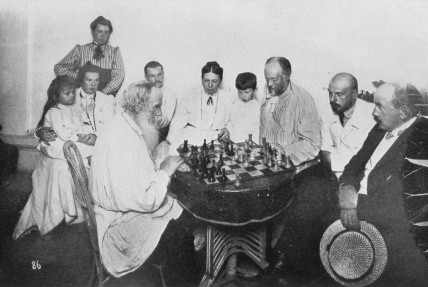
The second cause for surprise is that Ilya Tolstoy was himself a chess enthusiast. From page 11 of The Gambit, January 1929:
James Allen Anderson – Ilya Tolstoy‘Count Ilya Tolstoy, second son of the famous Russian author and novelist, played an exhibition game of chess 10 January 1929 with J.A. Anderson, city chess champion, following a lecture at the Downtown YMCA, St Louis, MO.
... Count Tolstoy has played with chessplayers the world over and knows personally such players as Alekhine, Capablanca, Lasker and Bogoljubow.’
1 e4 e5 2 Nf3 Nc6 3 Bb5 Nf6 4 O-O Nxe4 5 d4 exd4 6 Re1 d5 7 Nxd4 Qf6 8 f3 Bc5 9 c3 O-O 10 Bxc6 bxc6 11 fxe4 Qg6 12 Be3 Bg4 13 Qc2 Rae8 14 Nd2 Bh3 15 Nf1 dxe4 16 Qf2 Bxd4 17 Bxd4 f5 18 Qg3 Bg4 19 h3 Bh5 20 Qxg6 Bxg6 21 Bxa7 f4 22 Bd4 Rf5 23 b4 Rg5 24 Kh2 Rf8 25 Nd2 e3 26 Nf3 Rgf5 27 Nh4 Rg5 28 Nxg6 Rxg6 29 Rf1 Rg5 30 a4 Rgf5 31 a5 e2 32 Rf2 f3 33 Rxf3 Rxf3 34 gxf3 Rxf3 35 Re1 Resigns.
The above game-score was also given on page 30 of the February 1929 American Chess Bulletin, accompanied by this photograph of the occasion:
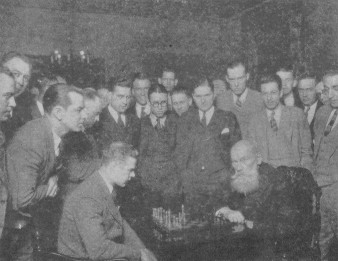
Two further photographs are added below. The first is a shot of Leo Tolstoy at the board, well known from its appearance in such books as The Soviet Chess School by A. Kotov and M. Yudovich (Moscow, 1983), whereas the second shows his two chess-playing sons Sergei and Ilya:
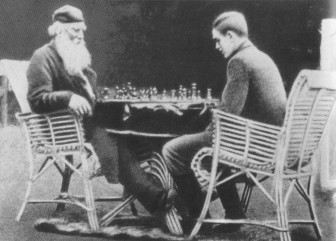

In conclusion, the main issue requiring clarification is which published games said to involve Leo Tolstoy are genuine. There seems no reason to dispute the authenticity of the three against Maude, but what of the others? Was the game against Ivkoff, given by Henschel, an invention? Were the two correspondence games played by Leo Tolstoy, or by one of his sons? And what can be discovered about the games allegedly played by Leo Tolstoy against Fritz Kuhler?
We now add the exact reference about Birdie Reeve by George Burns (who did not, however, mention her by name) on page 58 of his memoirs All My Best Friends (New York, 1989):
‘If you could do anything better, faster, longer, more often, higher, worse or differently than anyone else, you could work in vaudeville. For example, “The World’s Fastest Typist” had a great act. She’d type 200 words a minute, then pass the perfectly typed pages out to the audience to be inspected. For her finish she’d put a piece of tin in her typewriter and imitate a drum roll or the clackety-clack of a train picking up speed.’
No further biographical details have yet been found about F.D. Rosebault (C.N. 3559), but below is ‘a lively little game’ at the Manhattan Chess Club which he lost to an opponent who was playing blindfold:
Paul F. Johner – Frederick D. Rosebault1 d4 d5 2 Nf3 e6 3 Bf4 Nf6 4 e3 c5 5 c4 Nc6 6 Bd3 Bd6 7 Bg5 Be7 8 Nc3 O-O 9 O-O a6 10 Ne5 dxc4 11 Nxc6 bxc6 12 Bxc4 cxd4 13 exd4 c5 14 Qf3 Rb8 15 dxc5 Bxc5 16 Rad1 Qe7 17 Rfe1 Rxb2 18 Nd5 Qa7 19 Nxf6+ Kh8 20 Qh5 h6 21 Bxh6 g6 22 Qe5 Rxf2 23 Kh1 Bb7 24 Bg7+ Kxg7 25 Ne8+ Kh6 26 Qg7+ Kg5 27 h4+ Kg4 28 Nf6+ Kf5
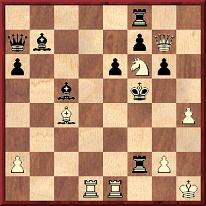
29 Re5+ ‘and mate in three’.
Source: Chess Weekly, 29 January 1910, page 142.
We have noted few references to notorious murderers having any interest in chess, but an apparent exception was the lethally charming Neville George Clevely Heath (born 1917). The following passage comes from page 189 of Portrait of a Sadist by Paull Hill (London, 1960) and describes the killer’s last days, at Pentonville Prison, London:
‘He spent a lot of time reading, made copious notes for his legal advisers, played a certain amount of chess with the warders, two of whom were in his cell day and night, and wrote a lot of letters to friends and his family.’

Neville Heath was hanged on 16 October 1946, the same day as, in Nuremberg, Hans Frank suffered the identical fate.
From page 78 of the first volume of Chess Characters by G.H. Diggle (Geneva, 1984), in which he referred to himself in the third person as the ‘BM’ (‘Badmaster’):
‘One of the BM’s earliest opponents was an eccentric but versatile Spalding lady some 50 years his senior, who for some fantastic reason was absolutely fascinated by the names of the Openings and who would turn over the pages of the BM’s MCO as though it were a picture book. She would even get the BM to go through with her the first three or four moves of any opening with a name that particularly “turned her on”, such as the Giuoco Piano or what she called the Kaiseritzky Gambit. Her main chess ambition was not to win a game (which she was shrewd enough to perceive would never happen) but to play an opening with a good resounding title, which gave her the same feeling of accomplishment as that of a ballroom dancer who had just performed the “Mayfair Quickstep” or the “Royal Empress Tango”. In her quest for additional strings to her bow she once discovered the “Max Lange” (16 columns including innovations from Marshall and Tartakower) and on being informed that Lange was a deceased nineteenth-century Master remarked that “he must have had a brain to have invented all that”.’
Even so, the Spalding lady’s delightful belief about Max
Lange’s brainpower is less naive than the misapprehension of
various newspaper and magazine editors that the chess
columnist/correspondent on their payroll requires any time, let
alone special grey matter, to fabricate his daily or weekly
feature when it largely consists of bare (or barely annotated)
game-scores which can be downloaded by anyone at the press of a
button.
There is no consensus on the quality of Lasker’s Manual of Chess and, in particular, on the former world champion’s way of expressing himself. The text below comes from page 15 of the second volume of Chess Characters by G.H. Diggle (Geneva, 1987):
‘An English edition of Dr Lasker’s “Chess Manual” had just come out to a most reverential reception by the critics. The Doctor, however, had by no means done his homework on Chess History, and furthermore had indulged in some obscure philosophy and phoney eloquence which, had it come from anyone else, might have raised an awful whisper of “Waffle!”: “La Bourdonnais died young in London, and the goddess of Chess, Caissa, very much grieved, mourned for him and forgot to inspire the masters with her sunny look ... And then – fickle Goddess – she gave her love to a young mathematician, the German Anderssen, and inspired him to superb combinations. And then – Oh the weakness of her – she spied with her great sunny eye in far distant Louisiana a boy ...”’
Reinfeld’s view, expressed on page vi of How to Play Better Chess (New York, 1948), was that the Manual ‘contains pages and pages of abstruse philosophical thinking, which is interesting but of no use to a beginner’, although he commented more favourably on Lasker’s style on page 139 of The Human Side of Chess (New York, 1952):
‘Lasker, who was a mathematician and a philosopher, often wrote about chess like a poet. Here is an example which has always impressed me: where Steinitz merely stated that the best target for attack is an immobile weakness, Lasker put the same idea in these words: “What is immobile must suffer violence. The light-winged bird will easily escape the huge dragon, but the firmly rooted big tree must remain where it is and may have to give up its leaves, fruit, perhaps its life.” This is pure poetry; there are no dragons; but the idea impresses itself more firmly on the mind of the learner than in the case of Steinitz’s more precise formulation.’
Lasker’s wordings in the above quotes vary slightly in the 1927 US edition of his Manual (page 129 and page 207) and in the 1932 UK edition (page 115 and pages 185-186). Furthermore, although this ‘immobile’ passage is one of his most famous quotes, the following appeared on page 12 of Second Book of Chess Strategy by G.M. Lisitsyn and B. Cafferty (London, 1976):
‘ ... as Nimzocvich [sic] put it so memorably, “What is immobile must suffer violence, since it cannot run away”.’
From W.D. Rubinstein (Aberystwyth, Wales):
‘In Gerald Abrahams’ essay “Assessment of Lasker”, originally (it seems) a Third Programme BBC broadcast but reprinted on pages 145-147 of Not Only Chess (London, 1974), there is this paragraph, in a review of Hannak’s biography of Lasker:
“Lasker was terribly lazy. The authors [sic] of the book do not say this, but it is written clearly between the lines. (With more energy he would have been a great mathematician.) I have it from Amos Burn and Gunsberg and Mieses that, in his early tournaments, Lasker was in the habit of driving up to the hall in a barouche or droshky, in order to find himself with 20 moves to make in as little as five minutes. I have it from Levenfisch that he showed the same inertia when they gave him opportunities for mathematical research at Moscow. He was content to ‘throw out ideas’.”
This does not sound like Lasker. Did he really arrive at tournaments with five minutes to spare? Abrahams was a barrister and a talented chess writer. He was born in 1907, but did he really have anecdotes like this from Amos Burn?’
C.N. 3559 indicated, on the basis of the 1900 and 1910 censuses, that Frederick D. Rosebault, Capablanca’s one-time business associate, was born in New York in July 1887, the son of Walter M. Rosebault. His mother’s forename was Sarah, and he had brothers named Leonard and Alfred. Although rock-solid proof of his demise was proving elusive, we also reported in that earlier item that a Frederick D. Rosebault who had served in Company G of the 51st Infantry Regiment, 6th Division died on 16 December 1945.
Now Russell Miller (Chelan, WA, USA) adds some intriguing complications. As regards, firstly, the military record, he notes that the website www.ancestry.com has, under ‘Ohio Military Men 1917-1918’, the following entry:
‘Frederick D. Rosebault
Residence: Canton, O.
Enlisted at Fort Thomas, Ky on 13 May 1918
Born Brooklyn, New York on 27 July 1888
Co G 51 Infantry to Discharge Private Honorable discharge 18 July 1919
Surgeon’s Certificate of Disability 15% disabled.’
Moreover, there is a World War I Draft Registration Card dated 8 June 1917 (Canton, OH) for Frederick Dana Rosebault, whose home address was given as YMCA, Canton, OH. It was furthermore stated that he was born in Brooklyn, NY on 27 July 1888, and the following particulars were added: ‘Special Officer for Canton Steel Foundry Co., no children, single, tall, blue eyes, brown hair, not bald, not disabled.’ The signature on the card was: Frederick D. Rosebault.
Next, our correspondent points out that the 1920 Federal Census listed, at 42 State St., East Orange, Essex Co., NJ, Walter Rosebault, his wife Sarah W. and their sons Frederick D. (aged 31, no occupation stipulated) and Alfred P. (occupation ‘US Army, Now in Europe’).
Finally, Mr Miller refers to the California Death Index at http://www.ancestry.com/search/db.aspx?dbid=5180. This lists a Sarah Parker, who was married to a man named Rosebault (forename not given), and a Frederick Danar Welles, who was born on 27 July 1888 in New York and died on 16 December 1945 in Los Angeles. Our correspondent suggests that Rosebault may have changed his name to Welles.
The evidence currently available does indeed strongly suggest that Frederick D. Rosebault, Frederick Dana Rosebault and Frederick Danar Welles were the same person. The one inconsistency in the birth-date is that the 1900 and 1910 censuses gave July 1887, whereas the other sources referred to above had (27) July 1888. (The year 1888 is also consistent with the above-mentioned reference to ‘aged 31’ for Frederick D. Rosebault in the 1920 census.) Both Frederick Dana Rosebault and Frederick Danar Welles are listed as having been born in New York on 27 July 1888 but, if they are indeed the same person, when and why did Rosebault change his surname to Welles? (The 1920 census listed his mother as ‘Sarah W.’ Did the W. perhaps stand for Welles?)
In fact, though, we can demonstrate a link between the names Rosebault and Welles. At the time Capablanca and Rosebault were in partnership, a brochure was issued by ‘Capablanca & Rosebault Chess Supplies and Literature, P.O. Box 1013, New York’. Just a few pages long, it was entitled A Brief Review of the Chess Record of José Raúl Capablanca, with the sub-heading ‘and the official announcement of his fourth American tour 1911-1912’. The author was named as Dana Welles.
Our copy of this extremely rare publication has seen better times, as may be noted from the reproduction below of the front cover:
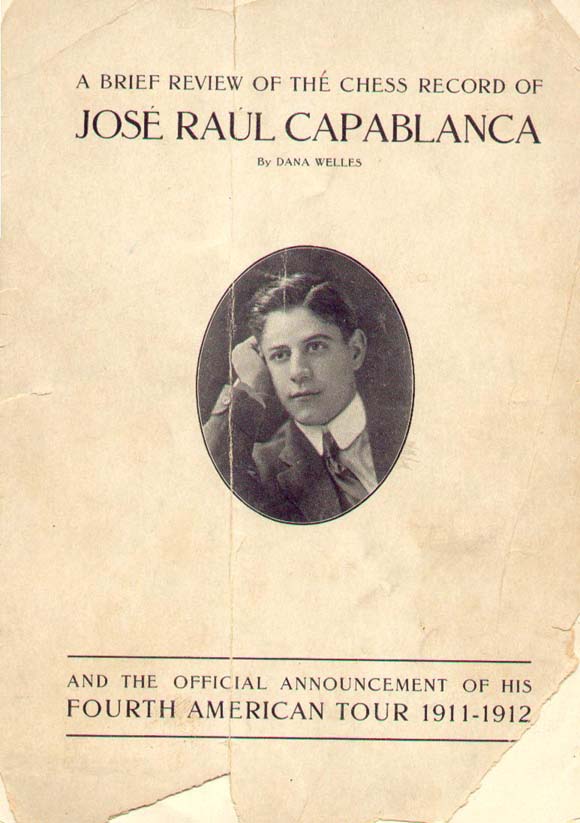
To summarize, the evidence currently available suggests that some time after the 1920 census Frederick Dana Rosebault changed his name to Frederick Dana Welles, having already used ‘Dana Welles’ as a pseudonym for the chess brochure which he issued jointly with Capablanca in 1911.
This photograph of Capablanca giving a simultaneous exhibition in Havana was included in the Dana Welles brochure discussed in C.N. 3674:

C.N. 3574 asked whether remarks about chess being ‘too much of a game to be a science and too much of a science to be a game’ and ‘too earnest for a game; too much of a game to be earnest about’ should be ascribed to the German philosopher and biblical scholar Moses Mendelssohn (1729-1786) or to his grandson, the composer Felix Mendelssohn (1809-1847).
No proper citation has yet been found, but it can at least be added here that page 48 of the Chess Player’s Chronicle, 11 July 1883 quoted as follows from a recent issue of the Jewish Chronicle: ‘And yet Mendelssohn said, “For a game, it is too serious, for study, it is too much like play”.’ The context implied, though no more than that, that Moses Mendelssohn was being referred to, and it is the only instance we have found so far of any such quotation in a pre-twentieth-century source.
From Jack O’Keefe (Ann Arbor, MI, USA):
‘Your doubts as to whether the Tolstoy correspondence games were played by Leo Tolstoy were well founded. On 27 March 1900 (all dates here are old style) the chess column in Novoe Vremia (page 5) listed some of the participants in its Fifth Correspondence Tournament. They included I.A. Zybin, B.I. Tabunshchikov, K.K. Betins, N.E. Kalinsky, A.I. Romashkevich, A.V. Henrichsen and four amateurs. As games from the tournament were printed over the following months it became clear that one of the amateurs was Leo Tolstoy’s son, Sergius (or Sergei) Tolstoy.’
Mr O’Keefe has provided all five games involving Tolstoy’s son which were published in Novoe Vremia. The first and third ones were mentioned in C.N. 3667 as being available in databases.
Sergei Lebedev – Sergius/Sergei L. Tolstoy
Correspondence (January – August 1900)
Queen’s Gambit Accepted
1 d4 d5 2 c4 dxc4 3 Nf3 Nf6 4 e3 Bg4 5 Bxc4 e6 6 Qb3 Bxf3 7 gxf3 b6 8 Rg1 c6 9 Nc3 b5 10 Be2 a5 11 Bd2 g6 12 Rc1 a4 13 Qc2 Nd5 14 Nxd5 exd5 15 e4 Bg7 16 e5 O-O 17 Bd3 Qe7 18 a3 Bxe5 19 dxe5 Qxe5+ 20 Kf1 Qxh2 21 Bxg6 Qh3+ 22 Ke2 Qe6+ 23 Be4+ Kh8 24 Qc3+ f6 25 Bh6 Rf7 26 Rg4 Nd7 27 Rcg1 Ne5 28 Qa5 Rfa7 29 Rg8+ Rxg8 30 Qxa7 Ng6 31 Rg4 dxe4 32 Rxe4 Ne5 33 Qd4 Nxf3 34 Kxf3 Qh3+ 35 Ke2 Qxh6 36 Re6 Qh5+ 37 Kd2 Qg5+ 38 Kc3 Qc1+ 39 Kd3 Qd1+ 40 White resigns.
Source: Novoe Vremia, 21 September 1900, page 5.
L.K. Stempovsky – Sergius/Sergei L. Tolstoy
Correspondence (January 1900 – June 1901)
Ponziani Opening
1 e4 e5 2 Nf3 Nc6 3 c3 d5 4 Qa4 dxe4 5 Nxe5 Qd5 6 Nxc6 bxc6 7 Bc4 Qd7 8 O-O Nf6 9 d3 exd3 10 Bxd3 Be7 11 Bf5 Qd6 12 Bxc8 Rxc8 13 h3 O-O 14 Qxa7 c5 15 Qa4 Ra8 16 Qc2 Qe6 17 b3 Nd5 18 Na3 Nxc3 19 Bb2 Ne2+ 20 Kh1 Nf4 21 Nc4 Rfd8 22 Ne5 Rd5 23 Qc4 Qf5 24 Ng4 Bd6 25 Qc3 Qg6 26 Qf3 Ra6 27 Rfe1 h5 28 Ne5 Qf5 29 g4 hxg4 30 hxg4 Qg5 31 Nc4 Bf8 32 Be5 Rh6+ 33 Kg1 Rxe5 34 Rxe5 Qh4 35 Rh5 Nxh5 36 gxh5 Rxh5 37 Re1 g6 38 Re5 Qh2+ 39 White resigns.
Source: Novoe Vremia, 12 July 1901, page 5.
Sergius/Sergei L. Tolstoy – A. Romashkevich
Correspondence (January 1900 – ?)
Ponziani Opening
1 e4 e5 2 Nf3 Nc6 3 c3 d5 4 Qa4 f6 5 Bb5 Nge7 6 d3 Be6 7 O-O a6 8 Bxc6+ Nxc6 9 Be3 Be7 10 Nbd2 O-O 11 d4 dxe4 12 Nxe4 f5 13 Neg5 Bd5 14 dxe5 f4 15 Bxf4 h6 16 Nh3 b5 17 Qc2 Qd7 18 Qg6 Qe6 19 Qg3 Bxf3 20 Qxf3 Nxe5 21 Qg3 Nc4 22 b3 Nd6 23 Rfe1 Qf7 24 Qd3 Rad8 25 Qc2 Ne8 26 Bg3 Bd6 27 Re3 Bxg3 28 hxg3 Nf6 29 Rae1 Ng4 30 Re4 Rde8 31 f3 Nf6 32 Rxe8 Rxe8 33 Rxe8+ Qxe8 34 Nf4 Nh5 35 Ne2 Qe5 36 Kh2 c5 37 c4 b4 38 Qd2 a5 39 Kh3 Nf6 40 Nf4 Qe8 41 Qd6 Nd7 42 Qe6+ Qxe6+ 43 Nxe6 Kf7 44 Nf4 Ne5 45 Ne2 Kf6 46 f4 Nd7 47 g4 g5 48 g3 Nb6 49 Kg2 a4 50 Kf3 a3 51 Nc1 Ke6 52 Ke3 Kf6 53 Kd2 Ke6 54 Kc2 Ke7 55 Nd3 Nd7 56 Nf2 Kf7 57 Ne4 Kg6 58 Kd2 gxf4 59 gxf4 Kf7 60 Ke3 Resigns.
Source: Novoe Vremia, 2 August 1901, page 4.
Sergius/Sergei L. Tolstoy – V.I. Tabunshchikov
Correspondence (January 1900 – ?)
Centre Game
1 e4 e5 2 d4 exd4 3 Qxd4 Nc6 4 Qe3 Be7 5 Bd3 Nf6 6 Qg3 d5 7 e5 Ng4 8 Nf3 h5 9 h4 Bc5 10 O-O Be6 11 Bg5 Qd7 12 Nc3 Be7 13 Bf4 O-O-O 14 Rfe1 Nb4 15 Bb5 c6 16 Ba4 g6 17 a3 Na6 18 Nd4 Nc5 19 f3 Nh6 20 Bb3 Nxb3 21 cxb3 c5 22 Nxe6 Qxe6 23 Bxh6 Rxh6 24 f4 d4 25 Ne4 Rd5 26 b4 cxb4 27 Nd6+ Bxd6 28 f5 Qd7 29 Qg5 Rh8 30 exd6 Qxd6 31 axb4 Rxf5 32 Qe7 Qb6 33 Rac1+ Kb8 34 Qe8+ Qd8 35 Qxd8+ Rxd8 36 Re7 d3 37 Rcc7 Rb5 38 White resigns.
Source: Novoe Vremia, 16 August 1901, page 5.
I.A. Zybin – Sergius/Sergei L. Tolstoy
Correspondence (January 1900 – October 1901)
Two Knights’ Defence
1 e4 e5 2 Nf3 Nc6 3 Bc4 Nf6 4 d4 exd4 5 Ng5 d5 6 exd5 Ne5 7 Qe2 Qe7 8 O-O h6 9 Nf3 Nxf3+ 10 Qxf3 Qc5 11 Qe2+ Qe7 12 Re1 Qxe2+ 13 Rxe2+ Kd8 14 Nd2 Bc5 15 Nb3 Bb6 16 h3 Re8 17 Rxe8+ Kxe8 18 Bf4 Bf5 19 Be5 Bxc2 20 Nxd4 Bg6 21 Nb5 Kd7 22 Nc3 Rd8 23 Na4 Kc8 24 Rc1 Ne8 25 Nxb6+ axb6 26 Bb3 f6 27 Bf4 Nd6 28 Rc3 Bf7 29 g4 Rd7 30 f3 Nb5 31 Rd3 c6 32 Be3 Bxd5 33 Bxd5 Rxd5 34 Rxd5 cxd5 35 Bxb6 Kd7 36 a4 Nd6 37 b4 Nf7 38 f4 Kc6 39 Bd4 Nd6 40 Kf2 g6 41 Ke3 f5 42 b5+ Kd7 43 Be5 fxg4 44 hxg4 h5 45 Bxd6 Kxd6 46 f5 d4+ 47 Kxd4 Resigns.
Source: Novoe Vremia, 11 November 1902, page 5.
Below are H.E. Dudeney’s solutions to his six problems in C.N. 3644:
One:
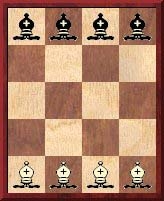
‘This is quite a fascinating little puzzle. Place eight bishops (four black and four white) on the reduced chessboard, as shown in the illustration. The problem is to make the black bishops change places with the white ones, no bishop ever attacking another of the opposite colour. They must move alternately – first a white, then a black, then a white, and so on. When you have succeeded in doing it at all, try to find the fewest possible moves.’
Solution: Dudeney showed that the task could be carried out in 18 moves. Numbering the board from 1 to 20 (i.e. with the black bishops on squares 1, 2, 3 and 4 and the white bishops on squares 17, 18, 19 and 20), he gave the solution as: 1 18-15 3-6; 2 17-8 4-13; 3 19-14 2-7; 4 15-5 6-16; 5 8-3 13-18; 6 14-9 7-12; 7 5-10 16-11; 8 9-19 12-2; 9 10-4 11-17; 10 20-10 1-11; 11 3-9 18-12; 12 10-13 11-8; 13 19-16 2-5; 14 16-1 5-20; 15 9-6 12-15; 16 13-7 8-14; 17 6-3 15-18; 18 7-2 14-19.
Two:
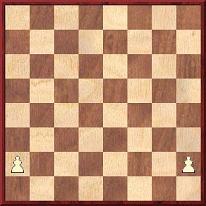
‘Here is a neat little puzzle in counting. In how many different ways may the two pawns advance to the eighth square? You may move them in any order you like to form a different sequence. For example, you may move the QRP (one or two squares) first, or the KRP first, or one pawn as far as you like before touching the other. Any sequence is permissible, only in this puzzle as soon as a pawn reaches the eighth square it is dead, and remains there unconverted. Can you count the number of different sequences? At first it will strike you as being very difficult, but I will show that it is really quite simple when properly attacked.’
Solution: ‘Call one pawn A and the other B. Now, owing to that optional first move, either pawn may make either 5 or 6 moves in reaching the eighth square. There are, therefore, four cases to be considered: (1) A 6 moves and B 6 moves; (2) A 6 moves and B 5 moves; (3) A 5 moves and B 6 moves; (4) A 5 moves and B 5 moves. In case (1) there are 12 moves, and we may select any 6 of these for A. Therefore 7 x 8 x 9 x 10 x 11 x 12 divided by 1 x 2 x 3 x 4 x 5 x 6 gives us the number of variations for this case – that is, 924. Similarly for case (2), 6 selections out of 11 will be 462; in case (3), 5 selections out of 11 will also be 462; and in case (4) 5 selections out of 10 will be 252. Add these four numbers together and we get 2,100, which is the correct number of different ways in which the pawns may advance under the conditions.’
Three:
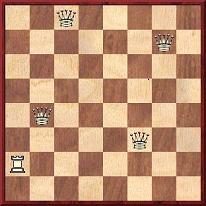
‘It will be seen that every square of the board is either occupied or attacked. The puzzle is to substitute a bishop for the rook on the same square, and then place the four queens on other squares so that every square shall again be either occupied or attacked.’
Solution: The queens are placed on d3, e4, c5 and h8.
Four:

‘Set up the position shown in the diagram. Then the condition of the puzzle is – White to play and checkmate in six moves. Notwithstanding the complexities, I will show how the manner of play may be condensed into quite a few lines, merely stating that the first two moves of White cannot be varied.’
Solution: The first two moves for White must be 1 e4 and 2 Qg4.
Five:
‘Starting from the ordinary arrangement of the pieces as for a game, what is the smallest possible number of moves necessary in order to arrive at the following position?
The moves for both sides must, of course, be played strictly in accordance with the rules of the game, though the result will necessarily be a very weird kind of chess.’
Solution: 1 Nf3 2 Nh4 3 Ng6 4 Nxh8 5 Ng6 6 Nxf8 7 Kxf1 8 Nc3 9 Na4 10 Nb6 11 Nxa8 12 Nb6 13 Nxc8 14 Nd6 15 Qe1 16 Nxe8 17 Kxe1. ‘Black plays precisely the same moves as White, and therefore we give one set of moves only. The above 17 moves are the fewest possible.’
Six:
‘I have a single chessboard and a single set of chessmen. In how many different ways may the men be correctly set up for the beginning of a game? I find that most people slip at a particular point in making the calculation.’
Solution: ‘The white pawns may be arranged in 40,320 ways, the white rooks in 2 ways, the bishops in 2 ways, and the knights in 2 ways. Multiply these numbers together, and we find that the white pieces may be placed in 322,560 different ways. The black pieces may, of course, be placed in the same number of ways. Therefore the men may be set up in 322,560 x 322,560 = 104,044,953,600 ways. But the point that nearly everybody overlooks is that the board may be placed in two different ways for every arrangement. Therefore the answer is doubled, and is 208,089,907,200 different ways.’
All six problems were taken from Amusements in Mathematics by H.E. Dudeney (London, 1917).
From page 106 of H.E. Dudeney’s 1917 book Amusements in Mathematics:
‘Some years ago the puzzle was proposed to construct an imaginary game of chess in which White shall be stalemated in the fewest possible moves with all the 32 pieces on the board. Can you build up such a position in fewer than 20 moves?’
The solution on page 232 was as follows:
‘Working independently, the same position was arrived at by Messrs. S. Loyd, E.N. Frankenstein, W.H. Thompson and myself. So the following may be accepted as the best solution possible to this curious problem:
1 d4 e5 2 Qd3 Qh4 3 Qg3 Bb4+ 4 Nd2 a5 5 a4 d6 6 h3 Be6 7 Ra3 f5 8 Qh2 c5 9 Rg3 Bb3 10 c4 f4 11 f3 e4 12 d5 e3. And White is stalemated.
We give a diagram of the curious position arrived at. It will be seen that not one of White’s pieces may be moved.’

It is Loyd’s name which is most commonly associated with the 12-move stalemate game, in the following version: 1 d4 d6 2 Qd2 e5 3 a4 e4 4 Qf4 f5 5 h3 Be7 6 Qh2 Be6 7 Ra3 c5 8 Rg3 Qa5+ 9 Nd2 Bh4 10 f3 Bb3 11 d5 e3 12 c4 f4.
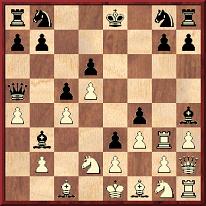
See, for instance, page 207 of The Puzzle King by S. Pickard (Dallas, 1996), the source being stipulated on page 237 as ‘1906, Lasker’s Chess Magazine’.
That 1 d4 d6 version of the game, with humorous annotations, did indeed appear in an article by Loyd on pages 137-138 of the January 1906 issue of Lasker’s Chess Magazine. It was subsequently reproduced and discussed on pages 127-129 of A.C. White’s Sam Loyd and His Chess Problems (Leeds, 1913), where White wrote:
‘The most quotable of Loyd’s contributions to Lasker’s is the amusing imaginary game ... in answer to the question: in how few moves can a game be played in which White is stalemated without loss on either side? J.C.J. Wainwright had found an ingenious solution in 15 moves (Sunny South, 1887), and methods analogous to Loyd’s were discovered independently, but almost simultaneously, by H.E. Dudeney, E.N. Frankenstein and W.H. Thompson. As far as I know, the actual priority has not been established. Loyd’s solution gains a good deal by the parody on conventional annotation contained in the notes to the moves made.’
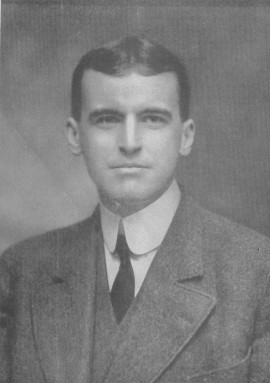
Alain Campbell White
Michael McDowell (Westcliff-on-sea, England) points out to us that T.R. Dawson wrote as follows about the synthetic game on page 22 of Ultimate Themes (Thornton Heath, 1938):
‘G.R. Reichelm [sic] proposed this theme in 1882 and gave a solution in 16. He republished this work in Sunny South in 1887, with a prize offer. J.C.J. Wainwright won the prize with a solution in 15, C.H. Wheeler second in 16. W.A. Shinkman saw this reprint and gave a solution in 13 in Brownson’s Journal, February 1887, whereupon C.H. Wheeler obtained the existing minimum solution in 12 and gave it in Sunny South in 1887: 1 a4 c5 2 d4 d6 3 Qd2 e5 4 Qf4 e4 5 h3 Be7 6 Qh2 Bh4 7 Ra3 Be6 8 Rg3 Bb3 9 Sd2 Qa5 10 d5 e3 11 c4 f5 12 f3 f4, stalemate as diagram, a lovely thing. But C.H.W. pointed out also the alternatives Black Qh4, KBb4, QRPa5, or Black Qh4, KBa5, also in 12 moves. Unfortunately for him, the problem was again re-set in the Leeds Mercury Supplement, 1895, and from there taken into the New York Clipper, 1895. In both these publications, the above three solutions were re-discovered by H.E. Dudeney, E.N. Frankenstein, S. Loyd and W.H. Thompson. As is well known, Loyd wrote an amusing anecdote round the solution in Lasker’s Magazine, January 1906, and thereby scooped all the credit! Now, I hope, it will return to its legitimate owners. This little history is based on a re-examination of the Sunny South chess column by J.C.J.W., and my study of the Leeds Mercury and N.Y. Clipper, while I had also the original m.s. solutions and notes of C.H.W., J.C.J.W. and E.N.F.’
Above his diagram of the final position Dawson gave ‘G.R. Reichelm [sic], Solved by C.H. Wheeler. Brentano, Jan. 1882’. We add the exact reference for the task, on page 455 of the January 1882 issue of Brentano’s Chess Monthly: it was one of 18 ‘nuts’ set by Reichhelm and read, ‘Play so that White can get stalemated in 16 moves without losing a man’. Can a reader send us any of the other, slightly longer solutions referred to by Dawson?

Gustavus Charles Reichhelm
On pages 6-7 of Chess Life, February 1981, in an article subsequently included on pages 93-97 of his book Karl Marx Plays Chess (New York, 1991), A. Soltis related that C.H. Wheeler found the 12-move game in 1887, as did K. Whyld on page 199 of the April 1992 BCM. Both failed to specify any source for their information. Soltis, furthermore, confused matters on page 11 of his book Sam Loyd His Story and Best Problems (Dallas, 1995) by writing:
‘ ... around the turn of the century there was an ongoing effort to construct the shortest possible game ending in stalemate. Eventually an Englishman named C.H. Wheeler found a 12-mover that went 1 d4 d5 2 Qd2 e5 3 a4 e4 4 Qf4 f5 5 h3 Be7 6 Qh2 Be6 7 Ra3 c5 8 Rg3 Qa5+ 9 Nd2 Bh4 10 f3 Bb3 11 d5 e3 12 c4.’
Such dense inaccuracy is quite common in Soltis’ output, and it should be noted that:
i) The construction effort took place in the 1880s, and not ‘around the turn of the century’;
ii) It was not ‘the shortest possible game ending in stalemate’ but the shortest possible game ending in stalemate without captures;
iii) C.H. Wheeler was American, not English (as Soltis could have discovered by consulting Gaige’s Chess Personalia);
iv) Black’s first move should read 1...d6, not 1...d5;
v) Soltis omitted the move which brought about the stalemate, i.e. 12...f4.
The following appeared on page 189 of the May 1914 BCM:
‘The Tijdschrift gives news of the “Batavian Capablanca”, Si Narsar. His simultaneous play at Java seems to have electrified the players in those distant parts; and we quote one of his recent games from the Tijdschrift:
White: Si Narsar Black: L...d. 1 a4 f5 2 h3 d6 3 d4 e5 4 Qd2 e4 5 Qf4 Be7 6 Qh2 Be6 7 Ra3 c5 8 Rg3! Qa5+ 9 Nd2 Bh4 10 f3 Bb3? 11 d5 (White is in a bad way, and speculates now on the avariciousness of his opponent.) 11...e3 12 c4 (A very fine piece of speculation.) 12...f4 (Black naturally falls into the trap. Stalemate. A most remarkable position.)’
This leg-pull was discussed by W.H. Watts on page 259 of the July 1914 BCM , with reference made to Loyd and Lasker’s Chess Magazine.
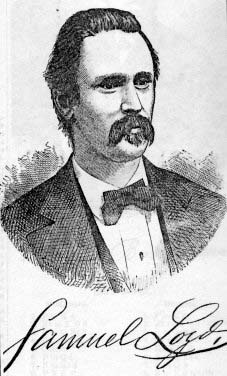
Loyd’s spoof article (i.e. with the 1 d4 d6 version of the game) was plagiarized in an unsigned article entitled ‘Justicia Reglamentaria’ on pages 157-158 of El Ajedrez Americano, October 1935. The players in the parody were named as Jesús Fernández and Ramón Pérez.
Half a century ago there was a brief revival of interest in the theme of short stalemate games after the following appeared, under the title ‘A record for all time?’, on page 351 of CHESS, 28 May 1955:
‘In how few moves, from the start-of-game position, can stalemate come about? Sam Loyd worked out a train of 12 moves, producing a position which has become world famous.
L.A. Edelstein of Oxford University has found a new solution in 11 moves only, totally different from Loyd’s.
He has the thrill of breaking a 71-year-old record, and establishing a new one which may stand for ever! Here is his version: 1 h4 e5 2 c4 d5 3 Qb3 dxc4 4 e4 cxb3 5 axb3 Qxh4 6 Rxa7 Rxa7 7 g4 Bxg4 8 Na3 Qxh1 9 Nf3 Bxa3 10 Ke2 Bb4 11 Ke1 Bxf3 Stalemate!’

It is not known why CHESS referred to a ‘71-year-old record’ (what had supposedly happened in 1884?), but the excitement was ill-founded and the ‘record for all time’ was flattened in the following issue (18 June 1955, page 383) after receipt of ‘a flood of letters’:
‘Firstly our Problem Editor [C.S. Kipping] corrects us by pointing out that S. Loyd improved on his stalemate in 11, with a solution in ten, as follows; his 12-move effort being subject to the condition: “No piece or pawn captured”.’
Then CHESS gave the famous ten-move Loyd game with captures, from Le Sphinx of October 1866 (see, for instance, page 58 of A.C. White’s book on Loyd): 1 e3 a5 2 Qh5 Ra6 3 Qxa5 h5 4 Qxc7 Rah6 5 h4 f6 6 Qxd7+ Kf7 7 Qxb7 Qd3 8 Qxb8 Qh7 9 Qxc8 Kg6 10 Qe6 Stalemate.
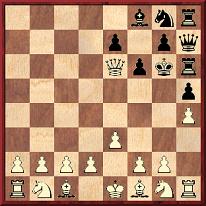
CHESS added that a number of readers, including Edelstein himself, had found that his own final position ‘can be reached in ten moves instead of 12!’ [sic – ten moves instead of 11], one possibility being 1 h4 e5 2 c4 d5 3 Qb3 dxc4 4 e4 cxb3 5 axb3 Qxh4 6 Ra4 Qxh1 7 g4 Bxg4 8 Nf3 Bxf3 9 Na3 Bxa3 10 Rb4 Bxb4 Stalemate.

Finally here, as regards the first discovery of the 12-move game without captures, it will be noted that when H.E. Dudeney and A.C. White named four persons they omitted the real discoverer, C.H. Wheeler (1846-1927). It must be hoped that justice will, at long last, be done to Wheeler (who was, according to W.A. Shinkman on page 210 of the December 1927 American Chess Bulletin, ‘exceedingly modest of his own powers’) for being the real inventor of 1 a4 c5 2 d4 d6 3 Qd2 e5 4 Qf4 e4 5 h3 Be7 6 Qh2 Bh4 7 Ra3 Be6 8 Rg3 Bb3 9 Nd2 Qa5 10 d5 e3 11 c4 f5 12 f3 f4, as published in Sunny South in 1887.
Below is the photograph which accompanied Shinkman’s tribute:
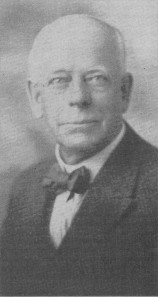
Charles Henry Wheeler
Chess Notes Archives:
| First column | << previous | Archives [8] | next >> | Current column |
Copyright 2005 Edward Winter. All rights reserved.